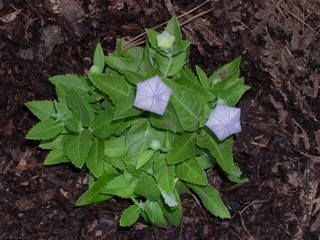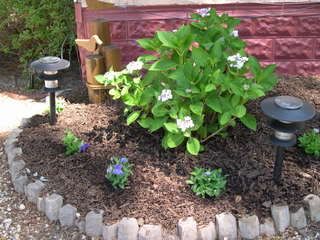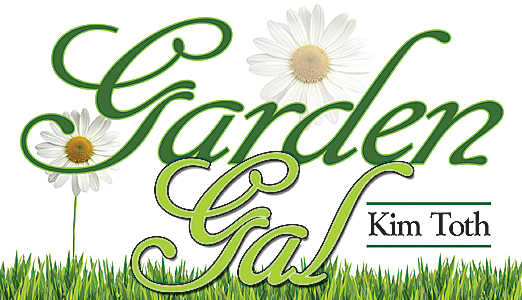Balloon Flowers
Hi, sorry to have left everyone hanging for so long, I was away on vacation last week, and as I've stated before, it takes me a couple of days to clear the mess on my desk here at work when I get back. I promise next time I'll give you an advanced warning.

Last night a friend and coworker of mine brought over some flowers she'd divided at her house. I was thrilled that she brought me some more of her vibrant balloon flowers!
What are balloon flowers? Well, I'm glad you asked...
Also known as the Chinese Bellflower, this heavy bloomer gets its name from the way each flower bud swells before its starry petals unfold. Balloon flowers are one of the easiest perennials you'll ever grow, and they bloom in profusion in mid to late summer, when many other perennials are beginning to fade.

The upward-facing flowers bloom throughout the summer and into early fall in shades of blue, pink and white. The plants form a low, neat mound and bear 2- to 3-inch cuplike blossoms accented with delicate purple veins and yellow stamens. Balloon flowers are a cottage garden standard, and they are excellent for cutting. To make the flowers last in the vase, sear the stems with a match or candle flame immediately after cutting.
Balloon flowers grow in Zones 3-8. They thrive in full sun or light shade in well-drained garden soil. They appreciate a little afternoon shade in our zone (6). You won't find a more carefree perennial! Just work a little slow release fertilizer into the soil in spring, and pick off the flowers as they fade to encourage more blooms. Moderate drought conditions aren't a problem, but it helps to water the plants deeply when the soil dries out too much or if drought conditions persist. Balloon flowers are seldom bothered by insects, and they are very cold-hardy.
I like this perennial so much, that we just added some to our landscape at our vacation home. These picture were taken there, just after they had been planted.

So go get some balloon flowers of your own, you won't be disappointed!
Coming up -- the showstopping Stargazer Lilly and my salad plate-sized Hibiscus flowers!

Last night a friend and coworker of mine brought over some flowers she'd divided at her house. I was thrilled that she brought me some more of her vibrant balloon flowers!
What are balloon flowers? Well, I'm glad you asked...
Also known as the Chinese Bellflower, this heavy bloomer gets its name from the way each flower bud swells before its starry petals unfold. Balloon flowers are one of the easiest perennials you'll ever grow, and they bloom in profusion in mid to late summer, when many other perennials are beginning to fade.

The upward-facing flowers bloom throughout the summer and into early fall in shades of blue, pink and white. The plants form a low, neat mound and bear 2- to 3-inch cuplike blossoms accented with delicate purple veins and yellow stamens. Balloon flowers are a cottage garden standard, and they are excellent for cutting. To make the flowers last in the vase, sear the stems with a match or candle flame immediately after cutting.
Balloon flowers grow in Zones 3-8. They thrive in full sun or light shade in well-drained garden soil. They appreciate a little afternoon shade in our zone (6). You won't find a more carefree perennial! Just work a little slow release fertilizer into the soil in spring, and pick off the flowers as they fade to encourage more blooms. Moderate drought conditions aren't a problem, but it helps to water the plants deeply when the soil dries out too much or if drought conditions persist. Balloon flowers are seldom bothered by insects, and they are very cold-hardy.
I like this perennial so much, that we just added some to our landscape at our vacation home. These picture were taken there, just after they had been planted.

So go get some balloon flowers of your own, you won't be disappointed!
Coming up -- the showstopping Stargazer Lilly and my salad plate-sized Hibiscus flowers!
 RSS
RSS



0 Comments:
Post a Comment
Links to this post:
Create a Link
<< Home